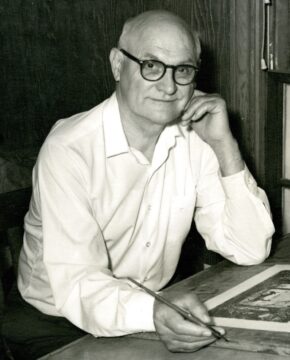
During the month of February, Rosenberg Library exhibited several original pen and ink sketches by Galveston artist Emil Bunjes (1902 – 1974). Though Bunjes is perhaps best known for his detailed renderings of Galveston’s most magnificent residences and historical sites, the sketches displayed included his scenes depicting the everyday lives of Galveston’s working class. These were donated to Rosenberg Library by Herbert Ganter and by the Galveston Wharf Company.

Born in Schulenberg, Texas in 1902, Emil Bunjes came to Galveston in 1924 to work as a bookbinder at Clarke and Courts Printing. He discovered his talent for drawing two years later after entering an art contest sponsored by the Galveston Daily News. Participants were asked to create a rendering of the famous Hollywood film star, Charlie Chaplin. Bunjes won second place and a $15 cash prize.
When he lost his job during the Depression, Bunjes used the opportunity to enroll in his first formal art course for the purpose of further developing his natural ability. He was eventually hired as a commercial artist for Alert Advertising, and also created art work for American National Insurance Company and for the Galveston Daily News. In 1939, Bunjes and his family moved to Houston where he was employed as an artist for a furniture company.

In 1966, the Galveston Historical Foundation published “Picturesque Galveston,” a portfolio of twenty-five drawings of local scenes by Bunjes. In honor of his 70th birthday in 1972, Rosenberg Library hosted a retrospective exhibit of his work. While he is best known for his pen and ink sketches, Bunjes also produced numerous paintings in oil and watercolor.
Bunjes said of the island: “Galveston, with its picturesque waterfront, its quaint architecture, its old-fashioned yards and alleys, and its many unusual characters, offers an inexhaustible source of study subjects for art students… Those who cannot afford academy training will find Galveston and vicinity a great academy, filled with interesting models, and with Mother Nature as our teacher.”
Bunjes died in Houston in 1974. Nearly 100 of Emil Bunjes’s paintings and drawings are preserved in the Museum Collection at the Rosenberg Library.